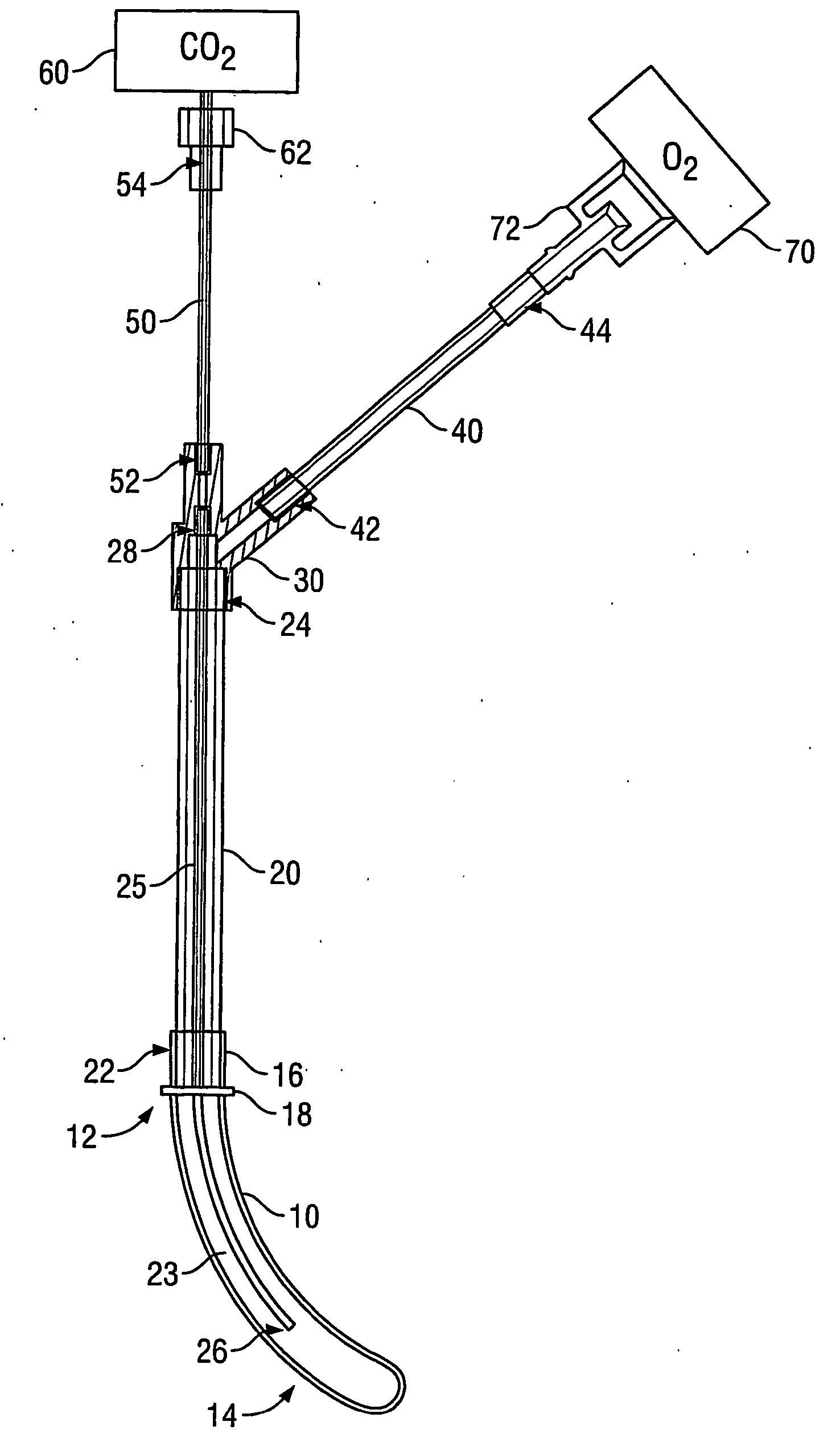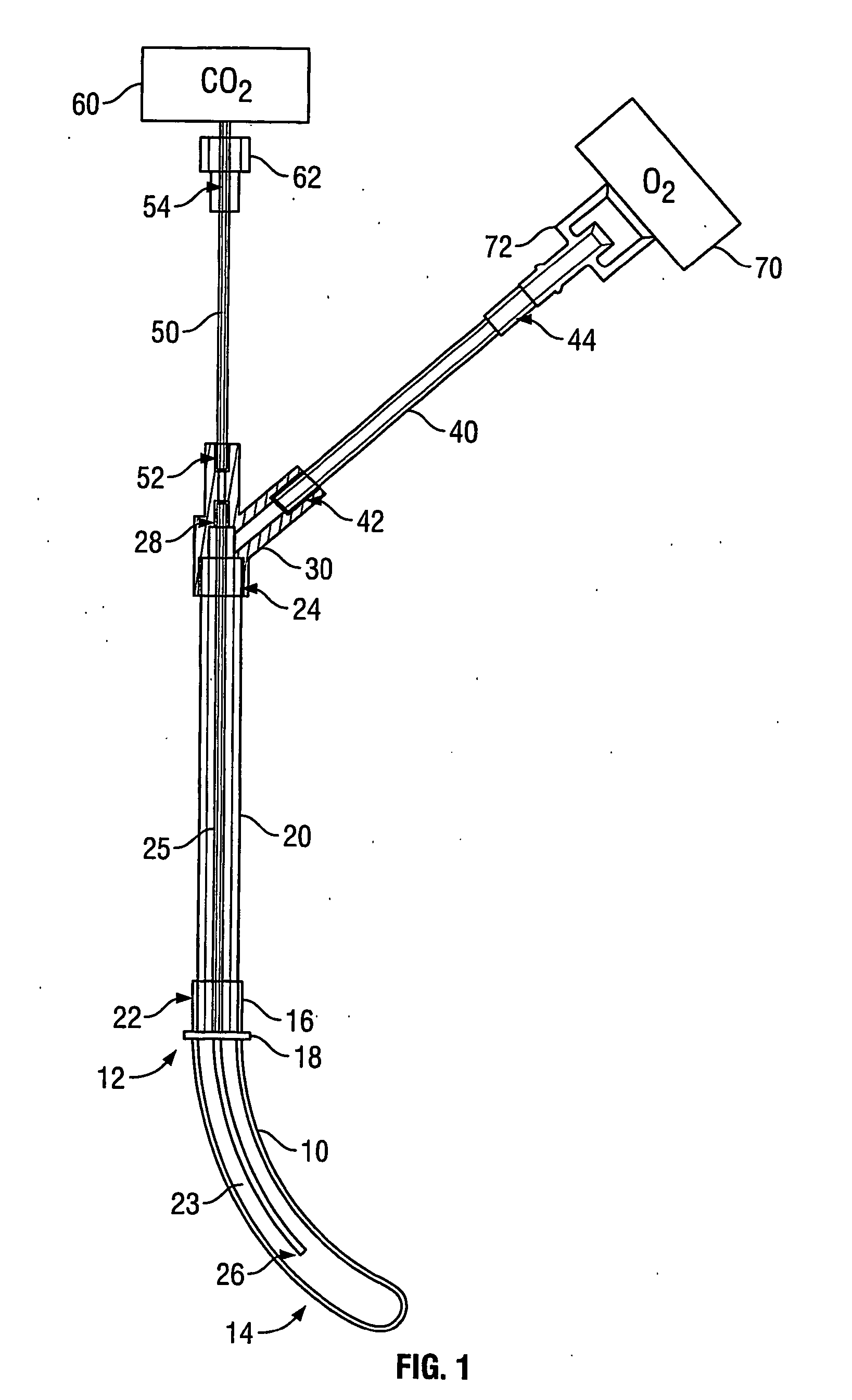Method and Apparatus for Transnasal Ventilation
a technology of transnasal ventilation and method, which is applied in the field of respiratory monitoring, can solve problems such as errors in the setup of equipment or equipment, and achieve the effects of reducing intrusion, reducing safety and control, and reducing the risk of infection
- Summary
- Abstract
- Description
- Claims
- Application Information
AI Technical Summary
Benefits of technology
Problems solved by technology
Method used
Image
Examples
example 1
1. Overview of Exemplary Embodiments
[0032] Referring to FIG. 1, in accordance with an exemplary embodiment, a transnasal ventilation apparatus might comprise an insertion guide 10, a first tube 20, a inner tube 25, a junction 30, a second tube 40, and a third tube 50. The first tube 20 might comprise a first end 24 and a second end 22. The inner tube 25 might comprise a first end 26 and a second end 28. The second tube 40 might comprise a first end 42 and a second end 44. And the third tube 50 might comprise a first end 52 and a second end 54. Further, the insertion guide 10, the first tube 20, the inner tube 25, the junction 30, the second tube 40, and the third tube 50 might comprise a single apparatus by, for example, being fused or otherwise bonded together or integral. Other embodiments are possible as well.
[0033] Referring to FIG. 1, the insertion guide 10 might comprise a proximal end 12 and a distal end 14. Although it need not be, insertion guide 10 might be tapered. For ...
example 2
1. Overview of Exemplary Embodiments
[0048] Referring to FIG. 3, in accordance with an exemplary embodiment, a transnasal ventilation apparatus might comprise an insertion guide 10, a first tube 20, a junction 30, a second tube 40, and a third tube 50. Referring to FIG. 4, in accordance with another exemplary embodiment, a transnasal ventilation apparatus might comprise an insertion guide 10, a first tube 20 fixedly attached to the insertion guide 10, a junction 30, a second tube 40, and a third tube 50, the junction 30 being integral with the first, second, and third tubes. FIG. 5 shows an exemplary embodiment similar to the exemplary embodiment of FIG. 4, but with the junction 30 being fused to the first, second, and third tubes. Although not shown, other embodiments are also possible. For instance, in another embodiment, the insertion guide 10 might be fixedly attached to the first tube 20, but the junction 30 might not be integral with or fused to any or all of the first, second...
example 3
1. Overview of Exemplary Embodiments
[0059] Referring to FIGS. 6 and 7, in accordance with another embodiment, a transnasal ventilation apparatus might comprise an airway, such as an insertion guide 10, a flow-through airway fitting 80, a first tube 20, a second tube 25, a third tube 40, and a fourth tube 50. The first tube 20 might comprise a first end 24 and a second end 22. The second tube 25 might comprise a first end 26 and a second end 28. The third tube 40 might comprise a first end 42 and a second end 44. And the fourth tube 50 might comprise a first end 52 and a second end 54. Although shown as separate components, the insertion guide 10, the flow-through airway fitting 80, the first tube 20, the second tube 25, the third tube 40, and the fourth tube 50 might comprise a single apparatus by, for example, being fused or otherwise bonded together or integral. Other embodiments are possible as well.
[0060] As shown in FIG. 6, the first tube 20 and the second tube 25 can be coup...
PUM
 Login to View More
Login to View More Abstract
Description
Claims
Application Information
 Login to View More
Login to View More - R&D
- Intellectual Property
- Life Sciences
- Materials
- Tech Scout
- Unparalleled Data Quality
- Higher Quality Content
- 60% Fewer Hallucinations
Browse by: Latest US Patents, China's latest patents, Technical Efficacy Thesaurus, Application Domain, Technology Topic, Popular Technical Reports.
© 2025 PatSnap. All rights reserved.Legal|Privacy policy|Modern Slavery Act Transparency Statement|Sitemap|About US| Contact US: help@patsnap.com



